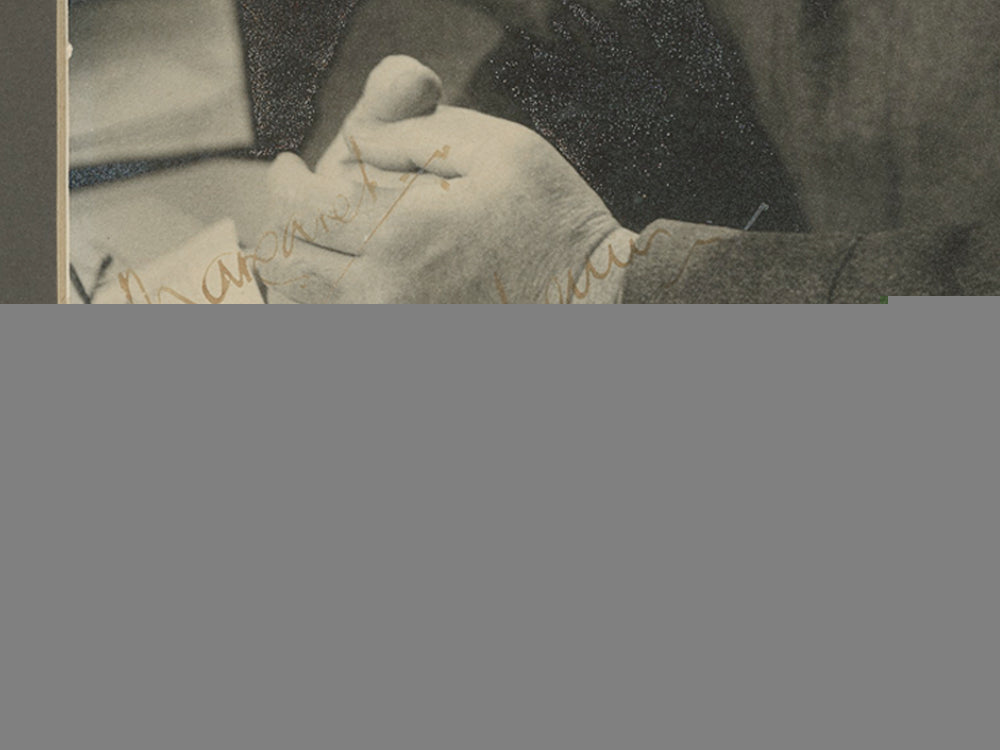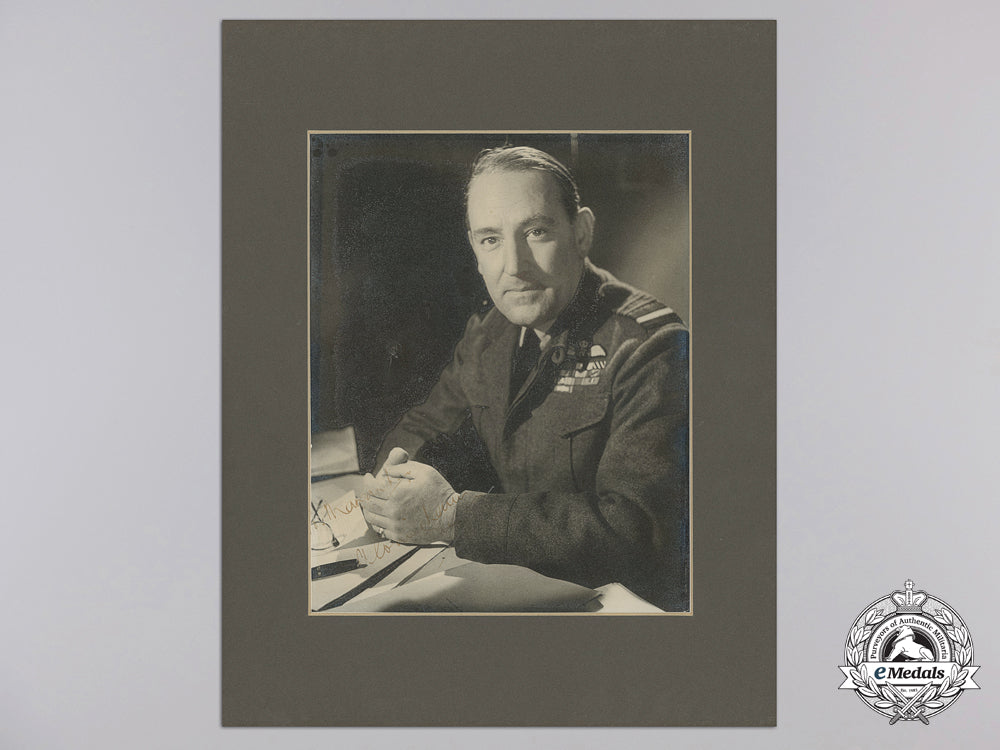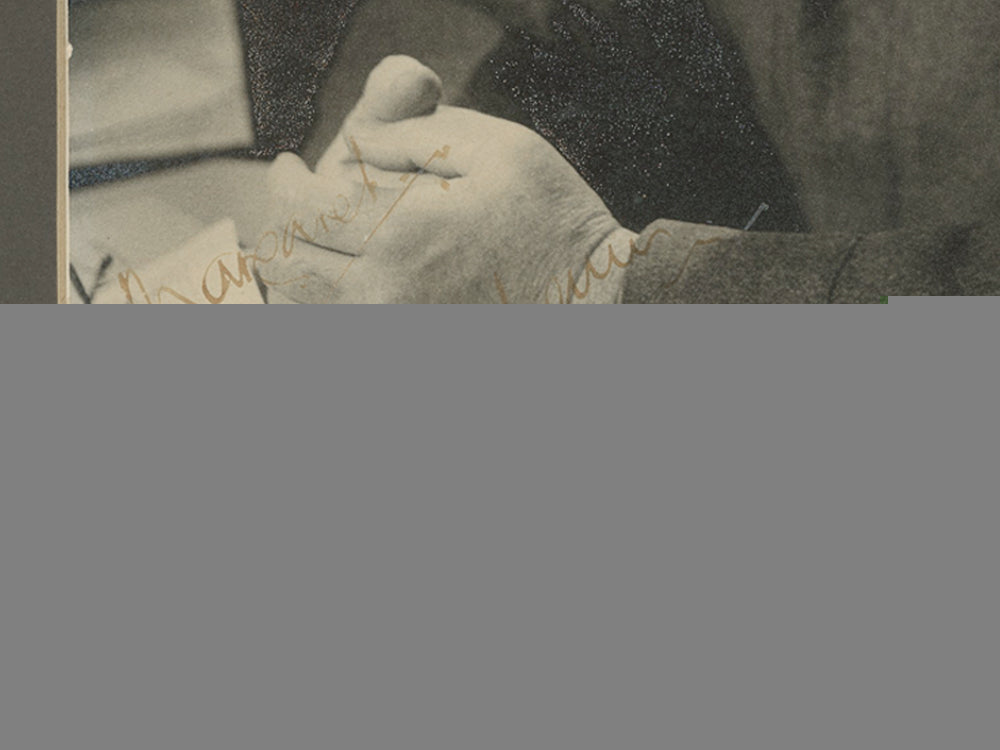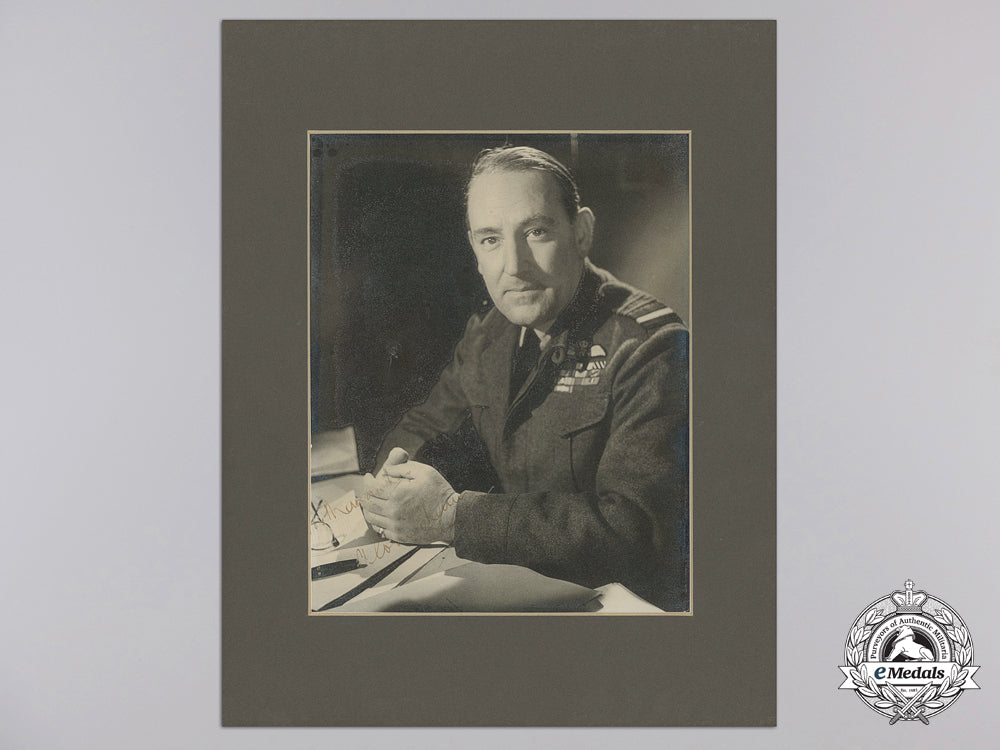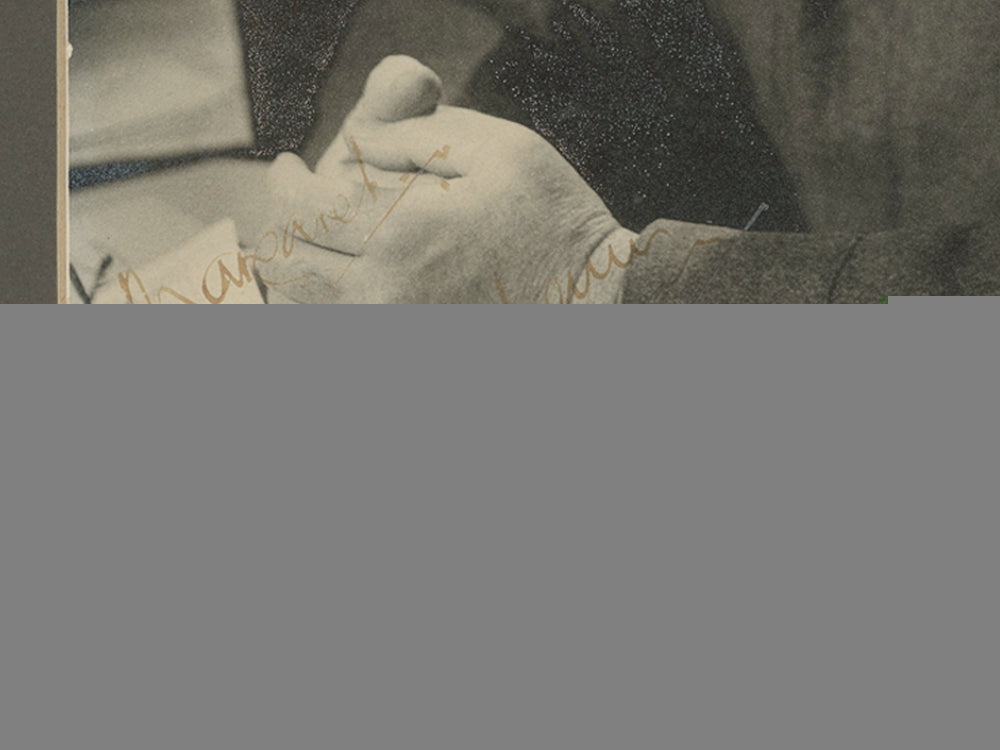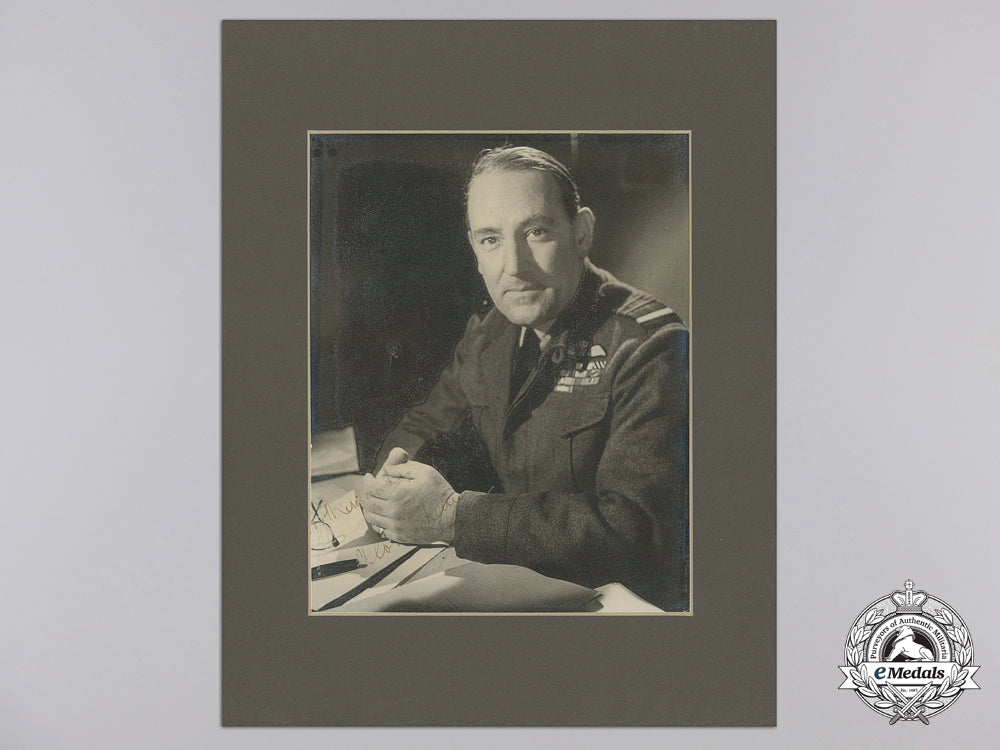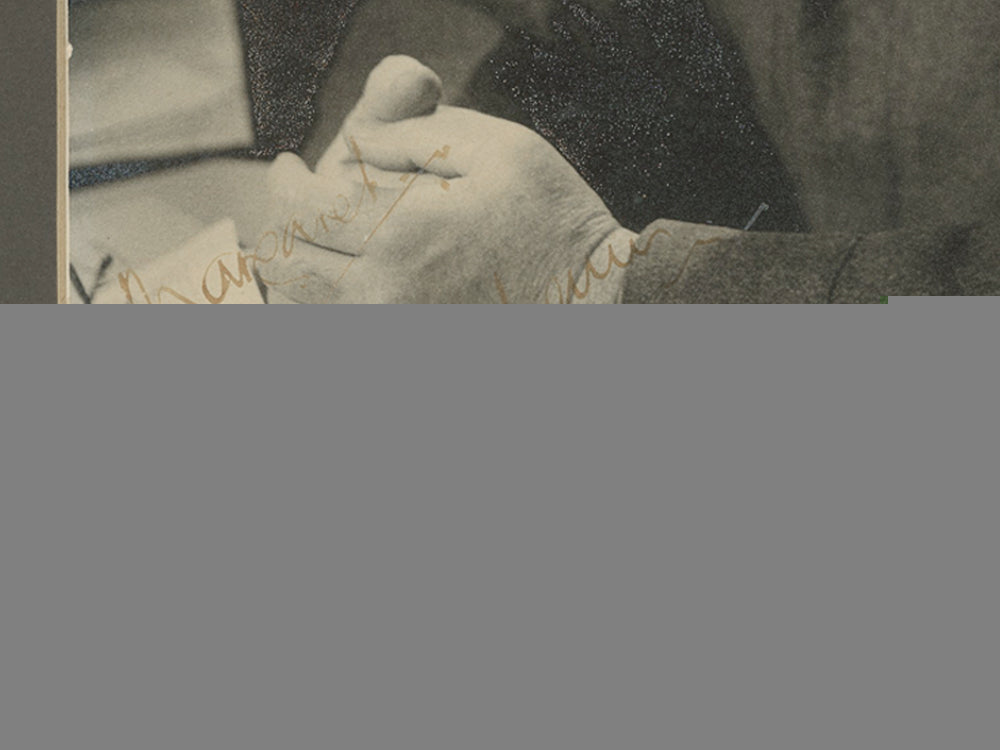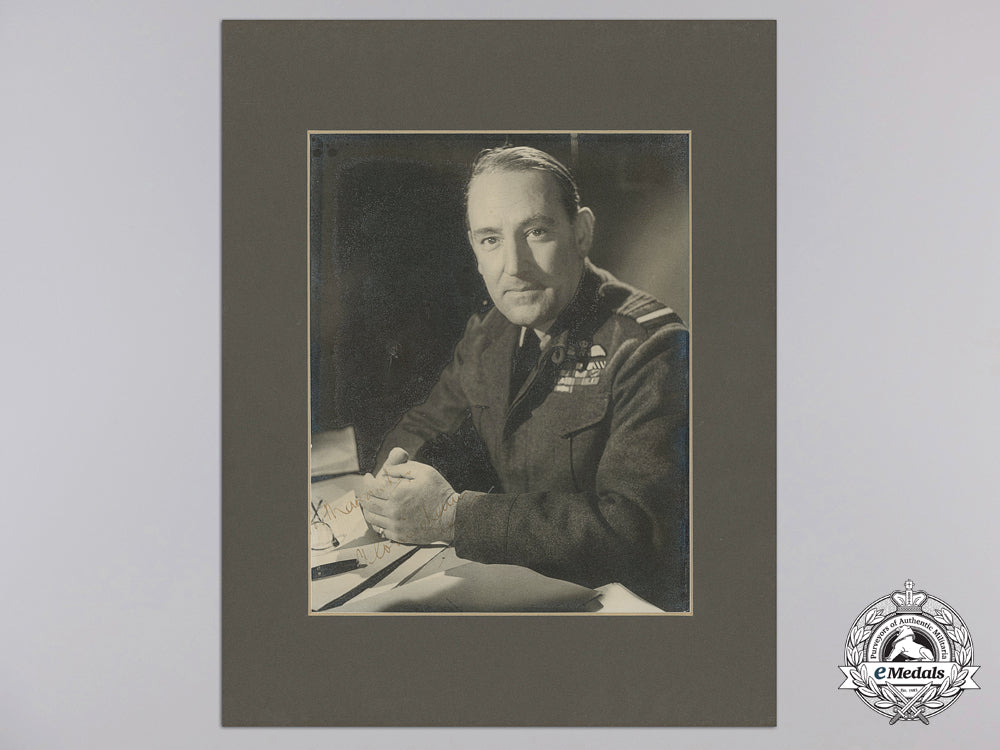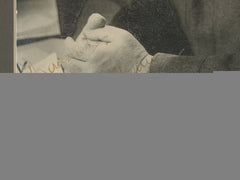Description
Black and white, illustrating Air Marshal Coningham seated at his desk, RAF wings and a four level ribbon bar on his left breast, Air Mashal insignia on his left shoulder, the photograph signed by Coningham at the lower left, 193 mm x 235 mm, mounted in a 277 mm x 354 mm beveled cardboard frame, scattered silvering, extremely fine.
Footnote: Air Marshal Sir Arthur "Mary" Coningham KCB, KBE, DSO, MC, DFC, AFC was born in Brisbane, Queensland, Australia, on January 19, 1895. His early life was one that made him learn to be adaptable. His father, also Arthur Coningham, was noted for playing Test cricket, but was by disposition, a con man, who was exposed in court for fabricating legal evidence in a trial designed to shake down a Catholic priest, Denis Francis O'Haran, Secretary to the Roman Catholic Archbishop of Sydney. The resulting scandal drove the older Arthur Coningham to remove the Coningham family to New Zealand while Coningham was still young. The change of scene to New Zealand did not change the father's modus operandi: he spent six months imprisoned there for fraud. The young Coningham was resilient enough and sufficiently motivated to win a scholarship to Wellington College. Although Coningham had won a scholarship, he was not an academic star. However, he was athletic and an outdoorsman, with expertise in horsemanship and with firearms. His parents divorced when he was seventeen, on the grounds of his father's infidelity. Arthur Coningham was maturely assured enough to remark, "Look here, Coningham, you may be my father, but I am ashamed of you." The comment reflects Coningham's persona: he was abstemious by nature, being a non-smoker, near teetotaler and impatient with obscene language. Coningham volunteered for service in the First World War with the New Zealand Expeditionary Force, in August 1914, initially seeing service in the conquest of German Samoa. He then served in Egypt and Somaliland as a trooper in the Canterbury Mounted Rifle Regiment, and was at Gallipoli, but developed typhoid fever. He was discharged in New Zealand as medically unfit for active service, invalided out of service in March 1916. In April, however, he travelled to Great Britain at his own expense and volunteered for the Royal Flying Corps. He was posted to 32 Squadron on December 19, 1916 after completing his flying instruction and flew numerous patrols between January 5 and July 30, 1917, when he was wounded during an aerial combat and invalided back to Britain. During the Battle of Arras, 32 Squadron undertook systematic strafing of German infantry and lines of communication, particularly suited for the Airco DH.2 machines they operated. Coningham returned to France and was promoted to the rank of Major, placed in command of 92 Squadron on July 1, 1918 at the age of 23. On August 11th, he was wounded again in a particularly intense air combat, but remained in France and resumed flying almost immediately. Through to the end of the war, Coningham's Royal Aircraft Factory S.E.5s conducted bombing and strafing attacks against German aerodromes, troops, gun positions and transport. In eleven months at the front, he was engaged in 176 patrols over enemy lines, was credited with the personal destruction of nine enemy aircraft and shared in the destruction of three others with Evander Shapard, Frank Billinge and Arthur Randell. He was also credited with seven victories for having driven down an enemy machine out of control. Coningham emerged from the war with two awards, a Distinguished Service Order and a Military Cross, both earned during his time with 32 Squadron. During that time he had also acquired the nickname "Mary," a corruption of "Maori" as a play on his earlier life in New Zealand. After the end of the First World War, Coningham remained in the Royal Air Force, initially remaining as Officer Commanding 92 Squadron. During the early 1920s, he served as a technical and flying instructor before being posted to 55 Squadron flying Airco DH.9As out of Mosul in Iraq. In the summer of 1923, he was promoted to Squadron Leader and appointed as the Officer Commanding of 55 Squadron. From early 1924 to early 1926, he carried out staff officer duties, first at the headquarters of Egyptian Group and then at the headquarters of RAF Middle East. While posted at Egypt Group, Coningham was assigned to lead a detachment of three DH.9As of 47 Squadron on a flight of 3,000 miles (4,800 kilometres) cross country, to introduce the first aircraft to Nigeria, while undertaking "a training exercise on an extended scale... using ordinary service equipment." Leaving Helwan near Cairo on the morning of October 27, 1925, the three aircraft reached Kano, Nigeria without serious incident on November 1st. The return trip, retracing their outward route, began early on November 12th and marked the first trip across Africa by air from west to east. They completed the estimated journey of 6,500 mi (10,500 km) in eighty hours of actual flying time, flying on sixteen of the twenty-four days of the mission, all without major difficulties. Coningham received an award of the Air Force Cross for the achievement. After further service at the Royal Air Force College, Cranwell and the Central Flying School, Coningham was promoted to Wing Commander in 1931. The following year, he was sent to the Sudan as the senior RAF officer, and while there, married Nancy Brooks Frank, widow of Sir Howard Frank, in July 1932. Upon his return to Great Britain in 1935, he took up staff duties in Coastal Area/Coastal Command before being promoted to Group Captain on January 1, 1937, serving as the Senior Air Staff Officer at the Headquarters of No. 17 (Training) Group. From 1937 to 1939, Coningham was the Officer Commanding RAF Calshot, a flying boat base. Coningham began the Second World War as an Air Commodore, commanding Bomber Command's 4 Group, which he led for two years including the first year of the bombing offensive against Germany. His group was small, seldom numbering more than sixty air crews in total for the first part of the war, and unlike the rest of Bomber Command, conducted its operations at night. Consequently, nearly all of the missions of its Whitley bombers before March 19-20, 1940 were for the delivery of propaganda leaflets over German territory against comparatively ineffective defences. During the remainder of 1940, 4 Group attacked targets in Italy, until these were allotted to 3 Group in December, and targets in the Ruhr, all of small scale and causing little damage. Coningham received a promotion in September to Air Vice-Marshal. In November, area bombing began, again on a small scale, and continued throughout the winter. 4 Group was just beginning to expand and convert its equipment to Handley Page Halifax bombers when Coningham was transferred. In July 1941, he was called to Egypt by Air Marshal Arthur Tedder, head of RAF Middle East Command, to take over 204 Group from Air Vice-Marshal Raymond Collishaw. Two months later, to match its growing size and its status with the newly formed Eighth Army, the group was transformed into the Western Desert Air Force. Coningham inherited a poorly functioning situation, where the Royal Air Force was almost totally failing to support ground troops. He promptly delegated out technical duties to those he trusted and did not micromanage them. However, he held his subordinates strictly responsible for achieving the results he wanted. Any mistakes by his underlings that resulted in fatalities to friendly troops were grounds for dismissal by Coningham. Faced with equipment shortages, a hostile desert environment, and superior enemy planes, Coningham's management system, through judicious deployment of his squadrons, gradually achieved air superiority in the North African campaign. In particular, he developed the use of fighter-bombers, able to fight as fighter planes in the air or in bombing and strafing attacks of enemy ground targets. He also developed an efficient ground support system to keep planes flying, and a command and control system to allow ground observers to radio in air attacks. Coningham's Western Desert Air Force, in continuous air attacks of enemy ground targets, was instrumental in stopping the enemy offensive at El Alamein in July 1942. He formed a close relationship with the new commander of the British Eighth Army, General Bernard Montgomery. Both Coningham and Montgomery recognized the importance of joint operations. The air power doctrine devised by Coningham is the basis of modern joint operations doctrine. The dominance of the Allied air force was a critical factor in the British victory at the Second Battle of El Alamein in November 1942. His doctrine of tactical air power would reach its fruition in early 1943, when the Royal Air Force and the United States Army Air Force fighter-bombers and bombers attacked enemy land forces. Coningham's doctrine was fundamental. He stated that the greatest attribute of air power was its ability to speedily concentrate its force. It followed that its command must also be concentrated. Tactical air power had to be closely coordinated with the ground forces, but the army could not command it. He stated as much in a pamphlet that was widely distributed, to every ranking officer in North Africa, so that they would know what to expect. The pamphlet included Coningham's priorities for success in use of tactical air power. First, gain air superiority. Second, use the air superiority gained to interdict enemy reinforcements of men and material to isolate the battlefield. Third, combine air attacks with ground assaults on the front lines. Coningham was knighted after El Alamein and continued to provide tactical air support for the Eighth Army until they occupied Tripoli in January 1943. Later in 1943, Coningham was promoted to Air Marshal and directed tactical air force operations in the Allied invasion of Sicily and Italy as commander of the Northwest African Tactical Air Force. As the leading exponent of tactical air warfare, Coningham was the obvious choice to command 2nd Tactical Air Force in the North-West European campaign under Air Marshal Trafford Leigh-Mallory, commanding the Allied Expeditionary Air Forces, and in January 1944 he was recalled to Britain where he helped plan air support for the Normandy landings. His relationship with Montgomery deteriorated markedly after the landings took place. The two often clashed when Montgomery regularly tried to bypass Coningham, who was the designated point of contact for air support requests, and deal directly with Leigh-Mallory. At the end of June, Montgomery lobbied Tedder, now deputy commander to United States General Dwight D. Eisenhower at Supreme Allied Headquarters, for Coningham's removal, after he criticized the army for tardiness in capturing Caen, in order to make available airfields for tactical aircraft. Tedder, however, advised Eisenhower that such removal would be "a disaster" and the criticism valid. In August 1944, Montgomery wrote to Alan Brooke that "Coningham is violently anti-army and despised by all soldiers; my army commanders mistrust him and never want to see him." However it was Montgomery who received a rebuke from Eisenhower, while Leigh-Mallory's headquarters was dissolved in October as an unnecessary command echelon. Coningham remained commander of the 2nd Tactical Air Force until July 1945, when he was replaced by Air Chief Marshal Sir Sholto Douglas and appointed head of Flying Training Command. He was a keen yachtsman and in 1947, was appointed Commodore of the Royal Air Force Yacht Club, then based at Calshot, however, he later oversaw the move to the current location at Hamble. Coningham's career ended on August 1, 1947, after thirty years of commissioned service and he requested that his retirement be shown as taking place at his own request. Air Marshal Sir Arthur "Mary" Coningham disappeared on January 30, 1948, when the airliner, G-AHNP Star Tiger, in which he was travelling to Bermuda was lost off the east coast of the United States, along with all the other passengers and crew, vanishing without a trace in the Bermuda Triangle. (C:28)

